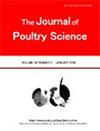用crisi - pitch方法将一种荧光蛋白基因敲入鸡原始生殖细胞的Vasa同源位点
IF 1.8
4区 农林科学
Q2 AGRICULTURE, DAIRY & ANIMAL SCIENCE
引用次数: 5
摘要
在鸡中,原始生殖细胞(PGCs)是高级基因组编辑(包括基因敲入)的有效靶标。虽然已经建立了鸡PGCs的长期培养体系,但仍需要选择一种高效、精确的基因编辑工具来编辑PGC基因组,同时保持其对生殖系统的贡献能力。聚类规则间隔短回文重复序列(CRISPR)/CRISPR相关蛋白9 (Cas9)和CRISPR介导的精确整合到目标染色体(CRISPR - pitch)方法具有优势,因为与传统用于产生敲入鸡的同源重组方法相比,供体载体更容易构建,基因组编辑效率高,并且不选择目标细胞。在这项研究中,我们利用crisi - pitch方法将一个荧光蛋白基因盒作为融合蛋白整合到鸡PGCs的vasa同源基因(CVH)位点,从而设计了敲入鸡PGCs。敲入PGCs在体外和体内表达荧光蛋白,便于PGCs的跟踪。此外,我们表征了工程双敲入细胞系的效率。通过限制稀释获得敲入细胞克隆,并通过基因分型证实了工程双敲入细胞系的效率。我们发现82%被分析的克隆被成功敲入两个等位基因。我们认为,用敲入PGCs生产模型鸡可以有助于各种研究,例如阐明鸡生殖细胞的命运和性别决定。本文章由计算机程序翻译,如有差异,请以英文原文为准。
Targeted Knock-in of a Fluorescent Protein Gene into the Chicken Vasa Homolog Locus of Chicken Primordial Germ Cells using CRIS-PITCh Method
In chickens, primordial germ cells (PGCs) are effective targets for advanced genome editing, including gene knock-in. Although a long-term culture system has been established for chicken PGCs, it is necessary to select a gene-editing tool that is efficient and precise for editing the PGC genome while maintaining its ability to contribute to the reproductive system. Clustered regularly interspaced short palindromic repeats (CRISPR)/CRISPR-associated protein 9 (Cas9) and CRISPR-mediated precise integration into the target chromosome (CRIS-PITCh) methods are superior as the donor vector is easier to construct, has high genome editing efficiency, and does not select target cells, compared to the homologous recombination method, which has been conventionally used to generate knock-in chickens. In this study, we engineered knock-in chicken PGCs by integrating a fluorescent protein gene cassette as a fusion protein into the chicken vasa homolog (CVH) locus of chicken PGCs using the CRIS-PITCh method. The knock-in PGCs expressed the fluorescent protein in vitro and in vivo, facilitating the tracking of PGCs. Furthermore, we characterized the efficiency of engineering double knock-in cell lines. Knock-in cell clones were obtained by limiting dilution, and the efficiency of engineering double knock-in cell lines was confirmed by genotyping. We found that 82% of the analyzed clones were successfully knocked-in into both alleles. We suggest that the production of model chicken from the knock-in PGCs can contribute to various studies, such as the elucidation of the fate of germ cells and sex determination in chicken.
求助全文
通过发布文献求助,成功后即可免费获取论文全文。
去求助
来源期刊

Journal of Poultry Science
AGRICULTURE, DAIRY & ANIMAL SCIENCE-
CiteScore
2.80
自引率
13.30%
发文量
26
审稿时长
12 months
期刊介绍:
The Journal of Poultry Science will publish original reports and reviews which either make an original contribution to fundamental science or are of obvious application to the industry. Subjects which are covered include: breeding and genetics, nutrition and feeds, physiology, reproduction, immunology, behavior, environmental science, management and housing welfare, processing and products, and health in poultry. Submission of original articles to the Journal is open to all poultry researchers. The review articles are invited papers written by international outstanding researchers. Articles will be published in English, American style.
 求助内容:
求助内容: 应助结果提醒方式:
应助结果提醒方式:


